There’s two ways to tell the story of the Fiat 500.
Story no. 1:
It seemed like a relatively simple trip. Two people, two duffel bags, one box of Easter flowers, a computer bag, one dog. But crammed inside the Fiat 500, no one was happy about the space allotted to them, the dog especially. Geez, there weren’t even kids tagging along for this trip.
Or, story no. 2
There’s this woman I know who loves tiny cars. She sees this little Fiat 500 and declares “This is a Rhonda car. Can I drive it?”
Look, there’s no denying the 500 is as cute as a teacup Italian greyhound. For many, that’s the appeal. And when it’s time to pack for a weekend up north? Well, pack light and bring gift cards to the local greenhouse.
Fiat has been gone from the U.S. market for 29 years. But when the company took control of Chrysler, it saw an opportunity to make its often-delayed return to the U.S. market. The car it decided to bring here first is the tiny 500, or Cinquecento in Italian.
The 500, which is designed to be reminiscent of the original ‘50s version, is quite popular in Europe.
But Europeans embrace small cars. So far, sales of the cars in this category have been sluggish on this side of the pond. Will Americans ever warm up to micro cars?
Frankly, it’s hard to make a case for the little 500 in a land that is dominated by wide-open spaces. Models with the good stuff aren’t cheap and it doesn’t even get great fuel mileage. Here’s an advantage: If you have a one-car garage, you might be able to cram two of them inside. Oh, that half space left over along the street? You’ll only have to fight the odd Smart ForTwo and the still rare Scion iQ for it.
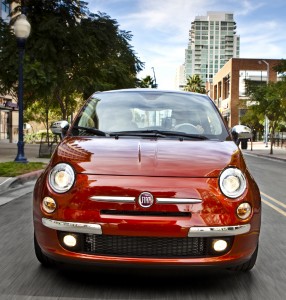
The 500 should appeal to those who spend a lot of time in cities where parking space is at a premium.
The Cinquecento can be fun to drive. There isn’t much power, and acceleration is leisurely, but it changes directions about as quickly as a go-kart. There’s a bit too much body roll, and the steering isn’t very quick and doesn’t have much feel.
The interior is in part a delight, but also a bit of a mish mash. In this Lounge model, the number three model in the 500 hierachy, the upper dash was covered in too-shiny black vinyl. A body color panel – in this case blue – stretches across the vertical surface of the dash. The gear shift surround is gloss black. The radio, climate control, instrument pod and steering wheel are all off white. Will the white steering wheel be a magnet for dirt?
Speaking of the leather, it’s luscious. This is the nicest leather available on a sub $30,000 car anywhere. The two-toned seats are brown on the bottom with ivory on top.
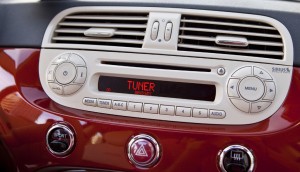
Will the white trim - which includes the radio, HVAC controls and steering wheel in the test car - show dirt quickly?
So there’s a lot of colors and textures going on here. But somehow, it looks good.
But tiny cars like the 500 have to have clever features to maximize the space. The 500 doesn’t have enough of them.
The seat cushion is tall, really tall. Looks like it was stolen from a DOT bus. Because the seat cushion is so thick, the seat doesn’t go low enough. At 5-foot-10, the top of my ballcap scraped the sunroof trim. I always felt like I was looking at the trailing edge of the sun visor. Taller folks should forgo the hole in the roof.
The visors are ridiculous. Even with both tiny visors flipped down, there’s plenty of spaces where the setting sun can shine through. Flip them around to use against the side windows and they barely extend past the A pillar and they don’t slide.
The TomTom navigation system looks like an aftermarket tack-on because it is. The removable nav unit sits on an oversized mount that plugs into the top of the dash and works with the Blue&Me infotainment system. Unfortunately, it blocks too much of what is already a small windshield.
The back seat is a bit of a joke. But I poured myself into the back seat just to see if a large adult could fit back there. With the front passenger seat pulled forward just one extra notch, I was able to sit back there, but body parts were starting to fall asleep within five minutes. If you buy one, never offer to drive if going out for dinner with another couple. They’ll never talk to you again.
There’s 9.5 cubic feet of space behind rear seats, but it’s a very vertical space, so it seems like less.
The 500 is powered by a 101-horsepower, 1.4-liter four. A five-speed manual is standard, but the test car was equipped with a six-speed automatic, which features what Fiat calls a “torque converter clutch” rather than a traditional torque converter. As long as you don’t hit the sport button on the dash, the trans is relatively smooth. The sport mode doesn’t seem to offer much change in the driving experience.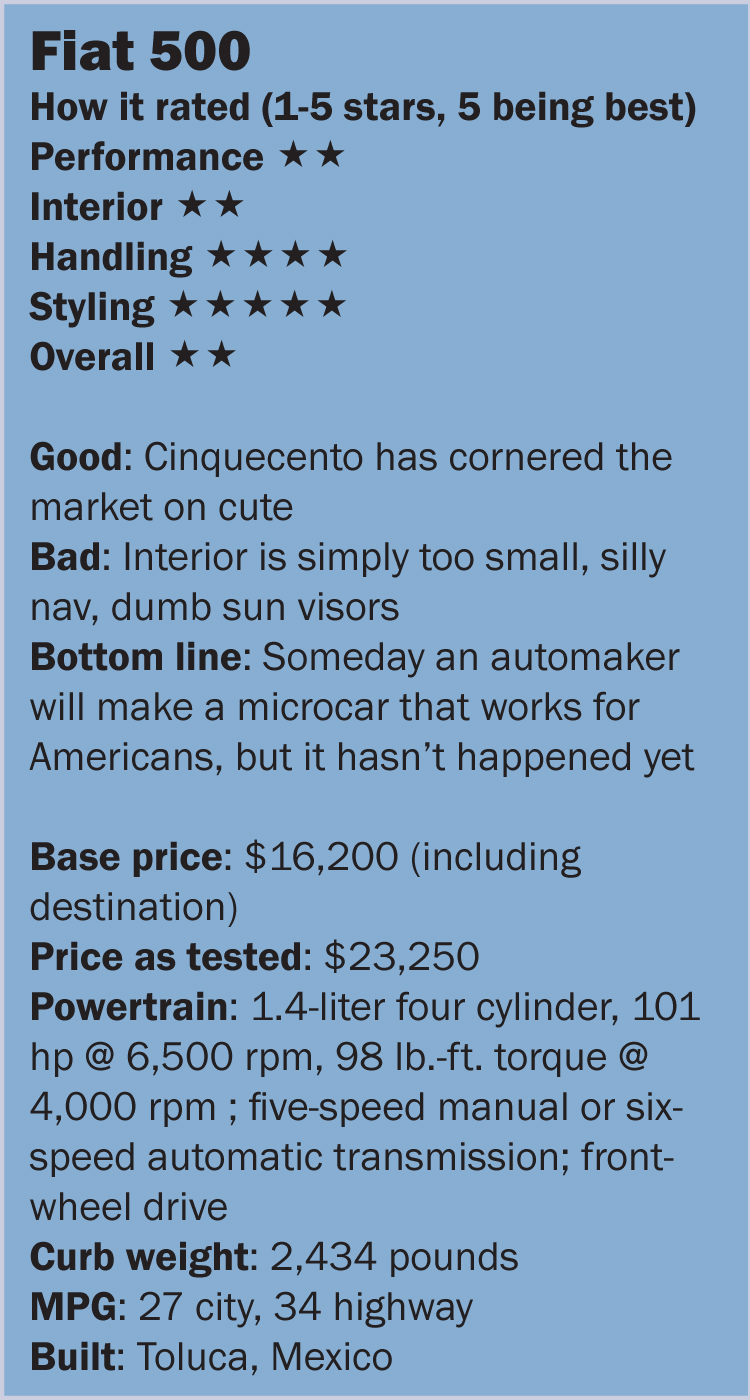
If fuel mileage is a priority, stick with the manual, which is rated at 30 city and 38 highway. The automatic reduces mileage significantly to 27/34. We saw 32 in mostly freeway cruising.
The 500 and other micro cars may be small, but don’t equate small with great fuel mileage. Their windshields are typically more upright, reducing aerodynamics, and their short length means airflow over the car ends in turbulence. This means that the engine has to work harder to push the car through the air.
Several much larger cars get better fuel mileage, particularly on the freeway, than the 500. Those looking for inexpensive, high-mpg cars should look at the Chevrolet Cruze, Hyundai Elantra, Ford Focus, Ford Fiesta, VW Golf and others, all cars that are significantly larger than the 500. All of those cars have more power and better acceleration, as well.
So it’s really cheap, right? Well, starting at $16,200 for the base Pop, the 500 starts low. And it’s no stripper model either with seven standard airbags, power locks, mirrors and windows, Bluetooth, leather-wrapped steering wheel, air conditioning and cruise control.
The Sport adds $2,000 along with a unique front and rear fascia, rear spoiler, 16-Inch aluminum alloy wheels, sport suspension, sport seats, sport steering wheel, red brake calipers, fog lamps and Bose stereo. And for another $2,000, the Lounge adds unique exterior trim, automatic trans, fixed glass roof, 15-inch aluminum wheels, upgraded seats, security alarm, satellite radio and automatic climate control. That’s already quite a chunk of change, but then come the options. The test car came with the $1,500 leather package (which also adds heated front seats, auto-dimming mirror and rear park assist), navigation for $400 and an $850 power sunroof. The bottom line was $23,250, which seems like a lot for a car with the Cinquecento’s limitations.
There’s that problem with making a case to buy a 500 again. It’s not significantly cheaper than other cars, all of which are much larger and won’t make the dog protest a ride up north.
But it’s so darn cute.

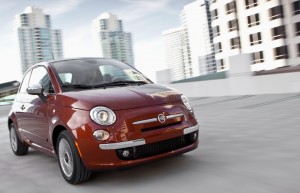
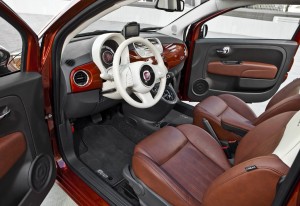
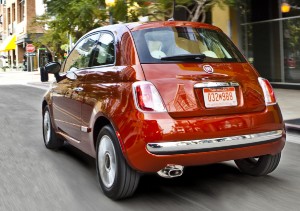
Thats why the Abarth makes more sense. Bare in mind all the negatives you bring up can be leveled at the Mini as well.That vehicle is even more expensive then the 500. I’ve seen some base Mini Coopers priced around 30 grand with options.There is very little rational in buying these cars but people do. Fiats sales are up this yr so far from last yr.If you look from a pure paracticality standpoint there is no reason to buy either the 500 or Mini.Thing is these cars invoke a passion and a sense of fun that trancends practicality.
Absolutely, agreed, Mini, that passion and a sense of fun to drive play a critical role in the marketing of small cars like Mini and Fiat 500. In Europe and some other markets — and a few rare U.S. cities, such as NYC — there is a practical sense, but it is more the emotional appeal here. That’s especially so considering they don’t deliver a measurable mileage advantage over larger — if less emotionally satisfying — competitors.
Paul A. Eisenstein
Publisher, TheDetroitBureau.com